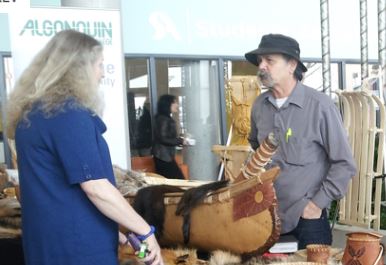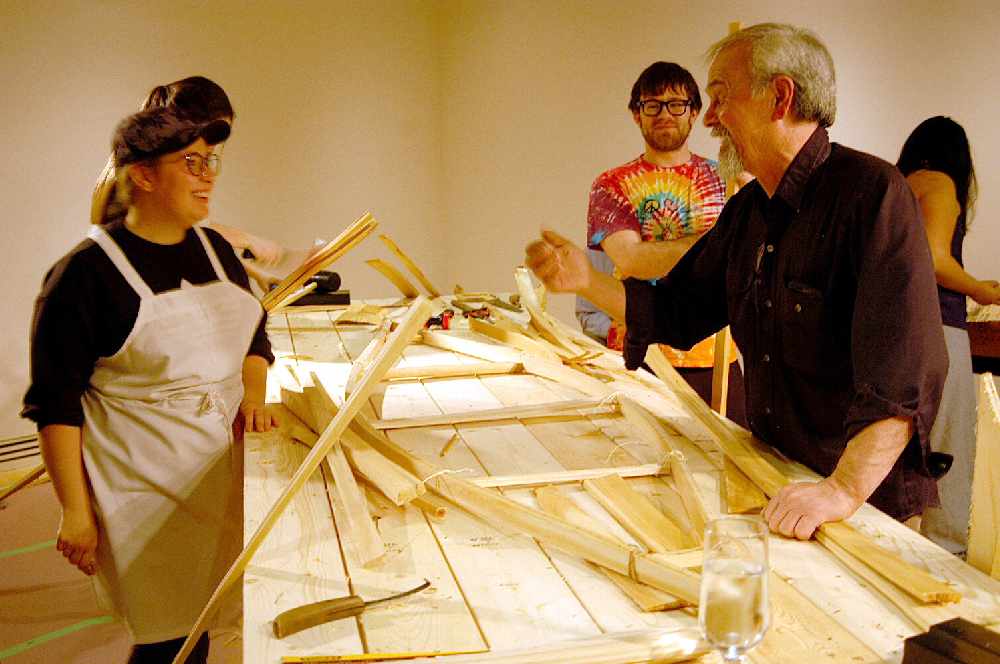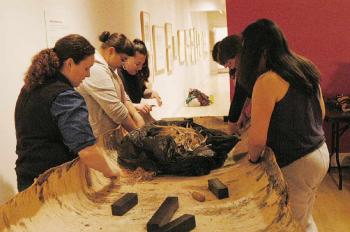Image Caption
Summary


Pinock Smith is in much demand with his three L's Anishinabe method of instruction: Look, Listen and Learn
By Brett Forester
Windspeaker.com Contributor
OTTAWA
Under the tutelage of Anishinabe master canoe builder Pinock, students at Ottawa’s Carleton University are creating a birchbark canoe from traditional methods and materials.
The seminar, composed of Indigenous and non-Indigenous students, meets once a week in a sawdust-strewn and wood-shaving covered corner of the university’s art gallery.
Commissioned in celebration of Carleton’s 75th anniversary, once its finished they hope to launch the canoe in the Rideau Canal, sometime in autumn, before it goes on permanent display in the university library.
For Pinock, the canoe is an enduring symbol of traditional Anishinabe ingenuity, philosophy, and culture; a sublime harmony of form, beauty, and functionality. For the university, the canoe represents a subtle, if tacit, acknowledgement that Carleton, and Ottawa itself, sit on unceded traditional Algonquin territory.
Hailing from Kitigan Zibi Anishinabe First Nation, roughly two hours north of Ottawa near the town of Maniwaki, Pinock is an internationally renowned and constantly sought after craftsman. He uses only traditional tools and traditional methods.
The necessary materials for the canoe consist of birch bark, cedar and ash for the frame and ribs, spruce twine for lashing, and spruce gum for waterproofing. Pinock harvests these various materials himself locally and in a sustainable, responsible fashion along his traplines north of Maniwaki.
He says that, nowadays, the biggest difficulty isn’t building canoes, but finding robust, healthy trees for the job. His workshop’s repertoire of tools consists of rubber mallets, a hammer, sharp knives, and a variety of chisels. And even these should be considered a luxury.
“Our ancestors didn’t have metal tools,” Pinock laughs. “They used stone and bone.” Indeed, there are no drills, no power saws, nor even measuring tapes – and not a nail in sight. The workshop boasts a makeshift birch sawhorse as its most intricate piece of technology.
The students don’t seem to mind.
A few of them are getting an academic credit for courses they’re already enrolled in. For the most part, however, the students have come for a break from the rigour of their academic careers, to relax and talk with their peers in a carefree environment. Most importantly, they have come to gain a different kind of knowledge.
They aren’t being graded. They aren’t being marked. And there are no passes or fails. Rather, what these students are learning is worth much more than any academic credit. They’re being introduced, whether they know it or not, into an entire worldview: a rich philosophy of sustainable development which subtly conveys humanity’s custodial relationship with the surrounding forests.
In other words, they’re building more than a birchbark canoe. They’re building tradition. They’re building community.
In this philosophy of education there are no strict deadlines, no stressful tests. There is no lecturing, note taking, and very little instruction. Students learn experientially, by watching demonstration and trying for themselves.
The journey is as important as the destination. It’s alright if a few cedar strips get broken in the process. This, Pinock remarks, is how he learned, and how he teaches.
As a youngster in Kitigan Zibi during the 1950’s, the traditional methods were much more common. The older generation engaged in traditional craftsmanship to supplement their income during economic hardship, or simply for their personal use.
Pinock refuses to say he’s “self taught” while, on the other hand, he remarks that no one formally showed him exactly how to build his canoes. Instead, he learned by what he calls “the three Ls” of Anishinabe education: look, listen, and learn.
No one is going to give you the knowledge you seek. You have to discover that for yourself. And so he would go off into the bush to harvest some materials, learning by trial and error, getting advice along the way.
Now he’s at the point where he passes on the knowledge, as well as the approach to life, which the method carries with it. And his wisdom is in increasingly greater demand for precisely these reasons. He’s held similar workshops in high schools across Ottawa, as well as other universities. One can see a finished canoe in the office of the Canada Council for the Arts.
He’s also held seminars for individuals overcoming addiction. The seminar allows Indigenous students to reconnect with their heritage. Non-Indigenous students have the opportunity to engage with an Anishinabe method of resource extraction, cultural production, and a different philosophy of man’s place in the world.
It gives everyone, student and non-student, Indigenous and non-Indigenous, a chance to build self-worth, identity, and a sense of individual belonging within the community.
A beautiful, yet functional, traditional Algonquin birchbark canoe will be the tangible result of their efforts. The intangible result of their labor will be whatever Anishinabe wisdom they gather for themselves.

